Cerebral Palsy Birth Injury
What Is It And When Is It Considered A Birth Injury?
Nearly four million babies are born each year in the United States, according to statistics from the Centers for Disease Control and Prevention.
 While most of these births result in healthy newborns, as many as 28,000 infants per year sustain an injury before, during, or shortly after they’re born.
While most of these births result in healthy newborns, as many as 28,000 infants per year sustain an injury before, during, or shortly after they’re born.
Sadly, many of these birth injuries could have been prevented.
Cerebral palsy is one of the most common types of birth injuries. Research shows that between 8,000 and 10,000 newborns and infants are diagnosed with the disorder annually. If your child was diagnosed with a cerebral palsy birth injury caused by medical negligence, you may be entitled to compensation. Here’s what you need to know if you’re considering legal action.
What Is Cerebral Palsy?
Cerebral palsy is a group of motor disorders caused by brain damage sustained during development, in the labor and delivery process, or shortly after birth. The most common disorder of its type, cerebral palsy affects approximately 500,000 children and adults in the United States, and more than 17 million people worldwide, according to the Cerebral Palsy Foundation.
The effects of cerebral palsy can vary by type and severity. The three main types of cerebral palsy are:
Spastic cerebral palsy. Caused by an injury to the brain’s motor cortex, spastic cerebral palsy accounts for 61–to–77 percent of cerebral palsy cases and causes permanent muscle contractions, stiff movements, and reduced mobility.
Athetoid cerebral palsy. Comprising just 6 percent of cerebral palsy cases, athetoid cerebral palsy is caused by an injury to the basal ganglia portion of the brain, and results in slow but involuntary movements and an inability to maintain balance and posture.
Ataxic cerebral palsy. Also representing 6 percent of cerebral palsy cases, ataxic cerebral palsy, which is caused by damage to the cerebellum, causes shaky movements, a lack of coordination, and balance and depth perception deficits.
Additionally, up to 50 percent of infants and children with cerebral palsy also suffer from a related seizure disorder or cognitive disability.
Cerebral Palsy Facts
There is no known cure for cerebral palsy.
Approximately 50 percent of cerebral palsy patients suffer from chronic pain.
Up to 50 percent of patients with cerebral palsy have a related intellectual impairment.
One in every three people with cerebral palsy has hip displacement or can’t walk.
About 25 percent of cerebral palsy patients have epilepsy.
Approximately 25 percent of cerebral palsy patients have a behavior disorder.
One in every five people with cerebral palsy can’t talk.
Twenty percent of cerebral palsy patients have a sleep disorder or require a feeding tube.
Medical Negligence-Related Causes of Cerebral Palsy
Medical negligence is a common cause of cerebral palsy motor disorders in newborns and infants. While not all cases of cerebral palsy can be prevented, proper prenatal care aids in both the prevention and detection of these disorders. When medical professionals fail to provide the accepted standard of care, birth injuries can result.
Negligence-related causes of cerebral palsy can include:
Failing to monitor the fetal heartbeat during and after delivery
Delaying a medically-necessary C-section
Failing to diagnose and treat maternal infections during pregnancy
Misuse of labor and delivery tools, such as forceps and vacuum extractors
Failing to diagnose and correct problems with the umbilical cord
Failing to detect oxygen deprivation in infants and provide oxygen in a timely fashion
Failing to properly monitor oxygen and respiratory treatments
Consult an Experienced Medical Malpractice Birth Injuries Attorney
Cerebral palsy is a lifelong illness with no known cure. If your child was diagnosed with a cerebral palsy motor disorder, you will likely incur significant expenses related to his or her treatment and care.
However, if the disorder was the result of medical negligence, you may be entitled to compensation. Do you have questions about a birth injuries case? Contact the Accident and Injury Law Group today to request a free, no-obligation initial consultation.
